
TOPIC: What Is The Best Sled Training Workout?

The Question:
We are always looking for variations to our workouts, especially if we are trying to increase strength and raise the level of our athletic achievement. Sled training may be one of those worthy of trying out.
What is the best sled training workout? Make sure to list weight used, distance, exercises, sets, reps, etc.
Who would benefit the most from this type of workout?
What risks are involved with this type of exercise and what safety precautions should be in place?
Bonus Question: Have you used this type of workout and would you recommend it to others?
Show off your knowledge to the world!
The Winners:
-
1. EAGLES56
View Profile
* Veeshmack View Profile
* Sain View Profile
-
Prizes:
-
1st place - 75 in store credit.
2nd place - 50 in store credit.
* Honorable Mention
To use your credit, e-mail Will @ will@bodybuilding.com for more info.

1st Place - EAGLES56
View This Author's BodySpace Here.

We are always looking for variations to our workouts, especially if we are trying to increase strength and raise the level of our athletic achievement.
Sled training may be one of those worthy of trying out.
In today's trendy training world, one often forgets about "The Sled." Sled training is an inexpensive way to increase strength and shear explosive power. All that one needs is a weightlifting belt, rope(s) and something to smoothly pull along the ground.
When trying to increase one's rate of acceleration and speed, squats are usually recommended. While squats train the muscles involved in running, they do not mimic it. Sled training works both hip extension as well as hip hyperextension; squatting only targets hip extension.
An article titled: 'Mechanical Basis of Human Running Speed' (also known as the Weyland Study) was published in The Journal of Applied Physiology which stated that:
"faster top running speeds are achieved with greater ground forces, not more rapid leg movements."
Hip hyperextension produces the ground force during running. Therefore, doesn't it make sense that one should increase their force production capacity to run faster by mimicking the motion of running?
This can be achieved alongside pure strength development through sled training.

Workout
What Is The Best Sled Training Workout? Make Sure To List Weight Used, Distance, Exercises, Sets, Reps, Etc.
 Exercises For Speed / Acceleration:
Exercises For Speed / Acceleration:
- Resistance Sprinting (forward or backward)
- Footwork Drills (lateral movements, shuffles, side step, etc)
- Lunges
- Bear Crawls
 Other Muscle Building Exercises:
Other Muscle Building Exercises:
- Leaning Triceps Extension
- Chest Presses
- Reverse Flye
- Low Pulls / Seated Row (facing backward, pulling the sled to one's stomach)
The exercise possibilities are endless since the sled is versatile and can easily replace cables. Sled training can be performed over a certain distance or to a specific repetition count.
 Sample Workout: Monday/Wednesday/Friday
Sample Workout: Monday/Wednesday/Friday
- 100m Chest Flyes
- 100m Rear Deltoid Flyes
- 100m Shoulder Press
- 100m Rotational Pulls
- 100m Low Pulls / Seated Row
- 100m Shoulder Press
- 100m Triceps Extensions
- 100m Bicep Rope Curl
- 200m Sprint
- 200m Backwards Run / Walk
- Bear Crawl 2x10
- Lunges 2x10
***Over the course of a football field or set distance in the park, perform as many repetitions as possible within the specified distance. Start off slow and increase the distance and/or weight each workout to provide progressive resistance.
This functional workout can be adjusted to further suit one's needs. The workout emphasizes continued explosive movement otherwise the sled will barely move across the ground. Not only does this workout target the chest, shoulders, triceps, and biceps but it also includes direct work to the posterior chain, hamstrings and glutes which are often forgotten.
| RELATED ARTICLE | ||
|

Who Would Benefit?
Who Would Benefit The Most From This Type Of Workout?
Anybody looking for a variation to their workout, increased speed and explosive power should consider sled training. The crude materials for sled training are inexpensive and easily constructed for those on a budget. Sled training also improves anaerobic and aerobic endurance which would supply that extra edge over the competition.

Risks
What Risks Are Involved With This Type Of Exercise And What Safety Precautions Should Be In Place?
As with any workout, diving into anything too fast will lead to injury.
Make sure to start off slow and gradually increase the volume and intensity.
Wear a proper harness that is reasonably comfortable that will not cause undue stress upon the body. If using a homemade sled, be sure that the rope attached in between the harness and sled is long enough that it will not cause the weighted sled to crash into one's legs or ankles.
If using a field, check for any holes or potential hazards contained within or on top of the terrain. One final note; start off at a moderate pace and then dial up the intensity to prevent any sudden 'jerking' of the weight since this type of activity leads to injury. When first starting, be sure to have obtained adequate rest and recovery before the next training session.
Recovery:

Bonus Question
Have You Used This Type Of Workout And Would You Recommend It To Others?
During football training I use sled training. This is a tough type of training which I don't recommend for the poorly motivated. I recommend this to the dedicated, since sled training increased both my strength and power in various ways which carry over into both my rugby and football game.
References:
EAGLES56

Honorable Mention - Veeshmack
View This Author's BodySpace Here.


Workout
What Is The Best Sled-Training Workout? Make Sure To List Weight Used, Distance, Exercises, Sets, Reps, Etc.
When training with a sled, you focus a lot toward time sprinting and time resting. Rest is ideal to getting maximum results from sled workouts. Reps should never be longer than 5 seconds in length, around 3 seconds is best. The average athlete would work toward going for 2 sets of four 3-second intervals.
In other words, sprint for 3 seconds, walk a meter, sprint for 3 more seconds, doing that two more times, then rest for about 2 minutes, and do it again. This can also be done using distances, but remember to keep distances short. You don't want to go run a 40-yard sprint with the sled because it's unrealistic, work in short 2-5-meter intervals in sets of 2. Sled training is best performed on speed days.
| RELATED ARTICLE | ||
|

Who Would Benefit?
Who Would Benefit The Most From This Type Of Workout?
The sled is probably one of the most effective ways for athletes and powerlifters to train their acceleration, speed and overall explosiveness. Although it would be most beneficial to these two groups, anyone can use the sled as all lifters look to increase strength and explosiveness. Mostly sprinters and athletes who take part in sports or events with a high demand for speed and acceleration currently use the sled.

Risks
What Risks Are Involved With This Type Of Exercise And What Safety Precautions Should Be In Place?
Sled training can be very hard if you don't properly rest between sets. You are training to be a sprinter with this form of training, so you need proper rest for personal safety and maximum benefit. A major problem athletes encounter with this is that many athletes tend to have sloppy sprinting form when using sleds.
For sprinters, form needs to be perfected for maximum results of the sled, whereas for athletes training for sports, the mechanics of form are not as important as Jim Wendler said,
"When you're running with the ball and a 250-pound lineman is on your back, your running mechanics aren't exactly perfect."
Knowing your limits is important with sled training. Sprinting alone will often do a number on your CNS, and doing it along with the sled can make it much harder on you, so it's ideal that you get rest and don't use the sled more than 2-3 times a week.
 |
1 of 3: The Central Nervous System (CNS):

The human central nervous system consists of the brain and spinal cord. These lie in the midline of the body and are protected by the skull and vertebrae respectively. This collection of billions of neurons is arguably the most complex object known. The central nervous system along with the peripheral nervous system comprise a primary division of controls that command all physical activities of a human. Neurons of the central nervous system affect consciousness and mental activity while spinal extensions of central nervous system neuron pathways affect skeletal muscles and organs in the body. |
 |
 |
 |
|
 |
||
A belt is also handy when using the sled; it will help keep your back from arching into uncomfortable positions.

Bonus
Have You Used This Type Of Workout And Would You Recommend It To Others?
I used this method last summer. I was invited to a strength and conditioning camp hosted by my city's Canadian Football League team. We went over many different training techniques for strength without ever stepping into the weight room.
Using the sled was one of the best pieces of equipment I have ever used for both getting faster, and becoming a more dominant runner who could power his way through defenders. I would recommend this to anybody looking to get faster and stronger, whether sport-specific or not, it definitely was great for me and can work wonders.
Vivak P. (AKA Veeshmack)

Honorable Mention - Sain
View This Author's BodySpace Here.

We are always looking for variations to our workouts, especially if we are trying to increase strength and raise the level of our athletic achievement. Sled training may be one of those worthy of trying out.

Workout
What Is The Best Sled Training Workout? Make Sure To List Weight Used, Distance, Exercises, Sets, Reps, Etc.
The most common type of sled training programs are aimed at developing the sprinting speed in athletes. This is done by creating endurance during a long-distance run. The athlete's body adjusts to dragging the extra weight, then when the weight is removed the athlete feels faster. After a couple of sled training sessions you can actually increase your acceleration and thus increase your speed.
How much weight to use? Start with towing about 10% of your body weight and add weight according to that. You do not want to be pulling a sled that is so heavy you're struggling to barely even move, but you also don't want a sled so light you don't feel any resistance at all.
Sled training isn't meant to completely take over your training program, but more as an addition to your strength or conditioning program. Because of this I recommend only sled training a max of twice per week.
 Sample Sled Day:
Sample Sled Day:
- 3 sets of 5 - Sprint 10 yds followed by a Backward Walk 10 yds
- 3 sets of 5 - Bear Crawls - 30 yds
- 3 set of 5 - Full Sprint - 50 yds
- 4 sets of 3 - Side Drags - 20 yds (rotate the way you face every set)
 Click Here For A Printable Log Of This Workout.
Click Here For A Printable Log Of This Workout.
Rest as long as you need, the object is to give 100% effort on each set. This is only a sample you can substitute with longer runs and different sled exercises. Here's a link to different exercises: www.elitefts.com.

Who Would Benefit?
Who Would Benefit The Most From This Type Of Workout?
Sprinters - Athletes who relay on quick burst of speed and fast acceleration. Those looking to add a bit of change to their program cheaply. A harness, rope and weight is all you need. You can use things like old tires or pieces of spare wood for weight and your squat belt or a backpack for a harness.
- Harbinger Presents: 5" Firmfit Belt
- Bodybuilding.com Presents: Power Up Padded Leather 4" Belt
- Schiek Presents: 2006 Lifting Belt
 View Lifting Belts Sorted By Top Sellers Here.
View Lifting Belts Sorted By Top Sellers Here.

Risks
What Risks Are Involved With This Type Of Exercise And What Safety Precautions Should Be In Place?
When sled training you should always be well hydrated, if you begin to feel nauseated, dizzy or light headed when working out ... Stop. Take a rest and try and cool down. Also since you will probably be pulling your sled in a grassy area, try to avoid uneven ground; this could lead to twisted ankles and other injury's.
| RELATED ARTICLE | ||
|
Try to avoid tall grass and brushes when pulling your sled - you never know what could be hiding in there. Something else to look out for when sled training is placing unnecessary pressure on your back. Try to keep the weight down, there's no need to be dragging your 12-year-old sister around when a 20-pound weight will do.
Finally make sure you use a proper belt or harness when pulling your sled; the wider the belt the more the load is distributed across your body and the less stress you feel.
References:



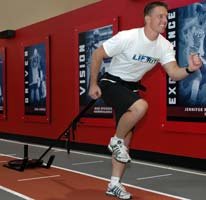

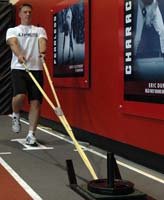
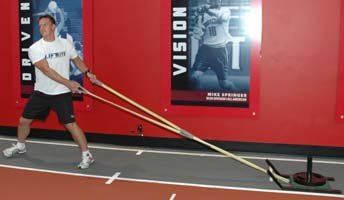
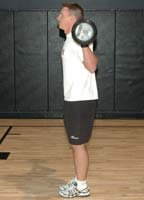
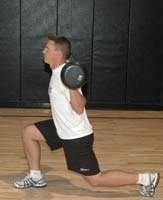
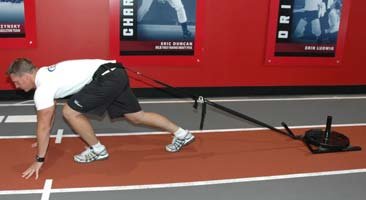
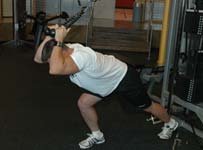
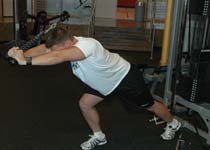
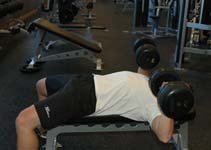
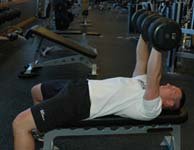
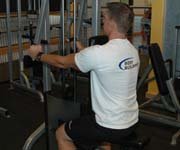
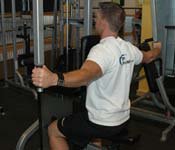
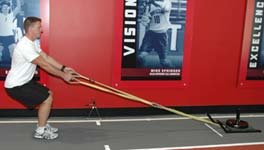



 Back
Back  Next
Next 